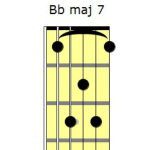Translating guitar chord symbols onto the guitar fretboard can often be frustrating and confusing.
Today we will demystify some of the most common ways that guitar chords are symbolized, so you’ll probably want to bookmark this page for future reference.
Our main focus will be on the most common guitar chords called triads.
A triad is simply a chord that contains three different notes. These notes can be doubled, or even tripled in the chord to produce four, five, or six string chord voicings.
Chord Symbolization Rule #1
The first thing you need to understand about interpreting chord symbols is the fact that chord symbols are not standardized. This means that you could pick up different books and sheet music and see the same chord symbolized quite differently. In some cases, you will find the same chord symbolized two different ways in the very same song! In other cases, you may find inconsistencies in how chords are symbolized within the same songbook, or magazine.
The good news is that as you start to understand how chords are symbolized and begin to understand the theory behind chords, you will be able to look at a chord symbol and determine exactly what the composer, arranger, or transcriber meant.
Chord Symbolization
When chords are symbolized, the following abbreviations are frequently used:
maj → for major
min → for minor
dim → for diminished
aug → for augmented
sus 4 → for suspended 4
sus 2 → for suspended 2
Major
Often, the major chord will have no indication following its letter-name. For example, the chords C maj, F maj and G maj, may be written as C, F, G.
Minor
Minor chords are often abbreviated as: “m”, “mi”, min, or a minus sign “—” is used.
Diminished
The diminished triad is sometimes symbolized as “dim”, “min b5”, or as “dim (triad)”. Often the degree sign ” ° ” is used. Bear in mind that “dim” is sometimes used to represent a diminished 7th chord. The diminished 7th chord is also sometimes symbolized with just a degree sign ” ° “.
Augmented
The augmented chord, which is usually abbreviated as “aug”, is sometimes symbolized with a plus sign “+”. For example, G+ and Ab+, would both be augmented triads. You should note that the plus sign is used to represent the major chord in some texts that cover classical music theory.
Suspended
The suspended 2 and suspended 4 chords are usually just symbolized as “sus 2″, and “sus 4″ respectively. Sometimes though, you will just see a chord symbolized as “sus” without a 2 or 4 following it. This usually refers to the sus 4 chord.
Power Chords
One other chord symbol that you will frequently encounter as a guitar player is the symbol for a power chord. Power chords are not triads. They consist of just two different notes and are sometimes called diads or dyads.
Power chords are most commonly written as the letter-name of the chord followed by the number 5. So a C5 is a ” C power chord”. You will also see the power chord written with the letter-name of the chord followed by “no 3rd”, “(no 3rd)”, “(no third)”, “omit 3″, or “(omit 3)”.
Chord Symbolization Rule #2
As you can see from the discussion above, capitalization is not used consistently. Some musicians will capitalize the “M” in major, others will not. Some use an upper case “M” for minor chord symbolization, others do not.
Below you will see a summary of the most common ways that the basic triads and power chords are symbolized.
Chord |
Common Symbols |
| Major | C, C ma, C Maj, C maj, C major, C Major, C+ |
| Minor | C mi, C min, C minor, C-, C m |
| Diminished | C dim, C°, C (dim), C min b5, C° (no 7), C° (omit 7) C min b5 |
| Augmented | C+, C aug, C aug 5, C #5, C +5 |
| Suspended 2 | C sus 2 |
| Suspended 4 | C sus 4, C sus |
| Power Chord | C5, C no 3rd, C (no 3rd), C (no third), C omit 3, or C (omit 3) |
To learn more about guitar chords, and learn guitar chords fast check out Guitar Essentials: Chord Master Expanded Edition.







Pingback: What's the Difference Between Dominant 7th and Major 7th Chords? | Guitar Accelerator Blog: Play Guitar - Over 100 Free Electric and Acoustic Guitar Lessons and Tutorials